Understanding and Leading Change in Organizations - Desklib
VerifiedAdded on 2023/06/15
|15
|5089
|236
AI Summary
This report discusses the impact of changes on different organizations and their strategies and operations. It analyzes the drivers of change and their impact on individual behaviors, team, and leadership. Measures to minimize negative impacts of change on organizations are also discussed. The report is based on the example of BMW, a Germany-based brand dealing in automobile manufacturing, designing, researching, promotion, and distribution. Get access to solved assignments, essays, and dissertations on Desklib.
Contribute Materials
Your contribution can guide someone’s learning journey. Share your
documents today.
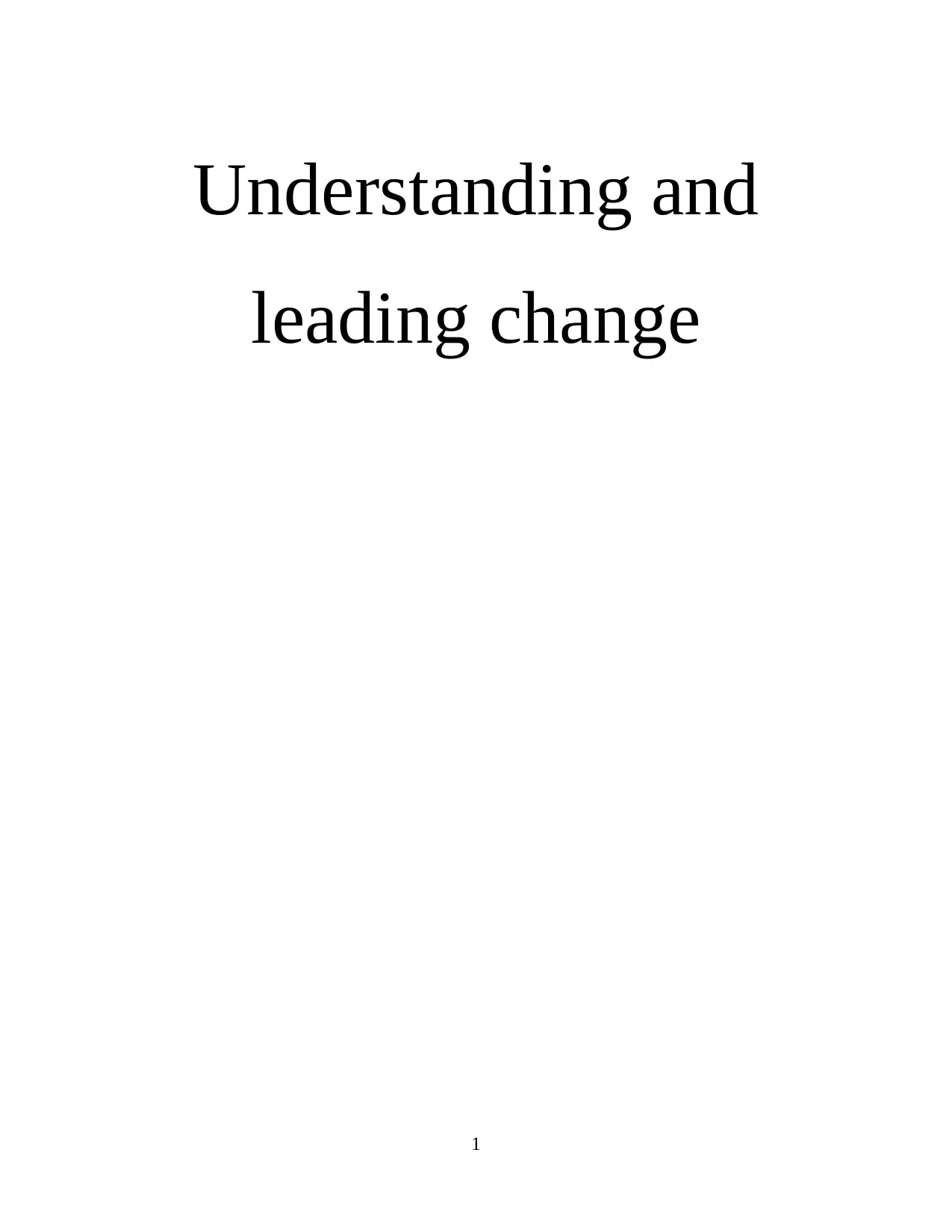
Understanding and
leading change
1
leading change
1
Secure Best Marks with AI Grader
Need help grading? Try our AI Grader for instant feedback on your assignments.
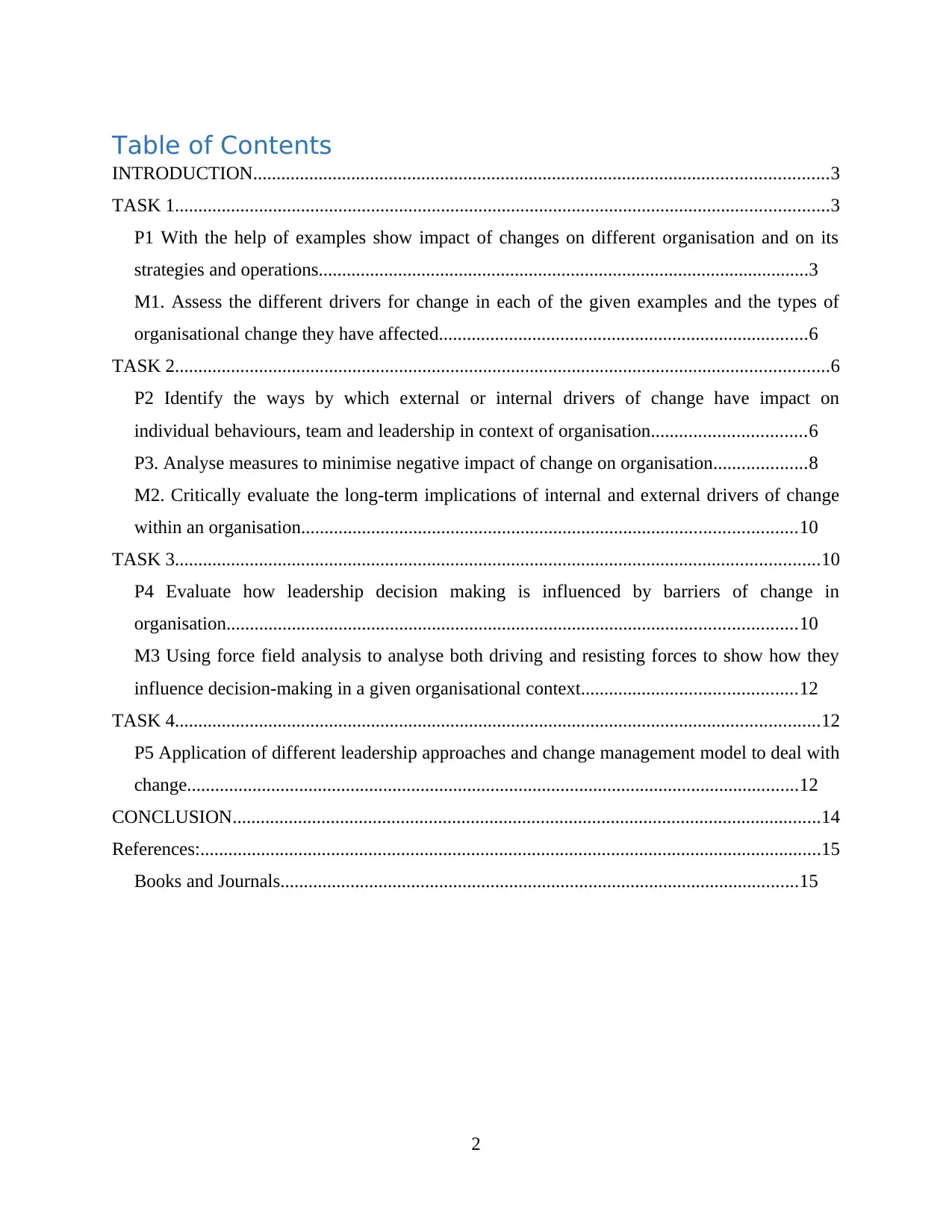
Table of Contents
INTRODUCTION...........................................................................................................................3
TASK 1............................................................................................................................................3
P1 With the help of examples show impact of changes on different organisation and on its
strategies and operations.........................................................................................................3
M1. Assess the different drivers for change in each of the given examples and the types of
organisational change they have affected...............................................................................6
TASK 2............................................................................................................................................6
P2 Identify the ways by which external or internal drivers of change have impact on
individual behaviours, team and leadership in context of organisation.................................6
P3. Analyse measures to minimise negative impact of change on organisation....................8
M2. Critically evaluate the long-term implications of internal and external drivers of change
within an organisation..........................................................................................................10
TASK 3..........................................................................................................................................10
P4 Evaluate how leadership decision making is influenced by barriers of change in
organisation..........................................................................................................................10
M3 Using force field analysis to analyse both driving and resisting forces to show how they
influence decision-making in a given organisational context..............................................12
TASK 4..........................................................................................................................................12
P5 Application of different leadership approaches and change management model to deal with
change...................................................................................................................................12
CONCLUSION..............................................................................................................................14
References:.....................................................................................................................................15
Books and Journals...............................................................................................................15
2
INTRODUCTION...........................................................................................................................3
TASK 1............................................................................................................................................3
P1 With the help of examples show impact of changes on different organisation and on its
strategies and operations.........................................................................................................3
M1. Assess the different drivers for change in each of the given examples and the types of
organisational change they have affected...............................................................................6
TASK 2............................................................................................................................................6
P2 Identify the ways by which external or internal drivers of change have impact on
individual behaviours, team and leadership in context of organisation.................................6
P3. Analyse measures to minimise negative impact of change on organisation....................8
M2. Critically evaluate the long-term implications of internal and external drivers of change
within an organisation..........................................................................................................10
TASK 3..........................................................................................................................................10
P4 Evaluate how leadership decision making is influenced by barriers of change in
organisation..........................................................................................................................10
M3 Using force field analysis to analyse both driving and resisting forces to show how they
influence decision-making in a given organisational context..............................................12
TASK 4..........................................................................................................................................12
P5 Application of different leadership approaches and change management model to deal with
change...................................................................................................................................12
CONCLUSION..............................................................................................................................14
References:.....................................................................................................................................15
Books and Journals...............................................................................................................15
2
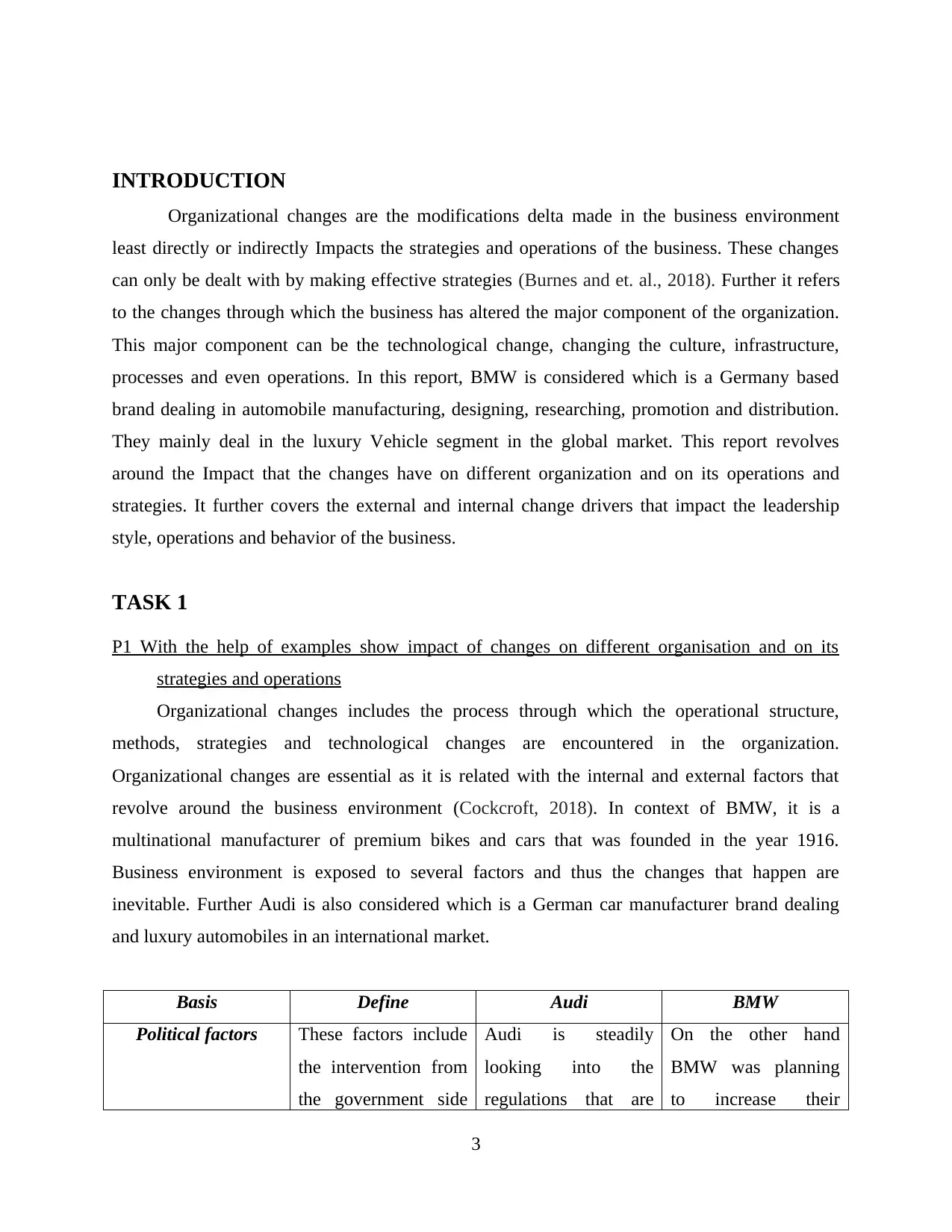
INTRODUCTION
Organizational changes are the modifications delta made in the business environment
least directly or indirectly Impacts the strategies and operations of the business. These changes
can only be dealt with by making effective strategies (Burnes and et. al., 2018). Further it refers
to the changes through which the business has altered the major component of the organization.
This major component can be the technological change, changing the culture, infrastructure,
processes and even operations. In this report, BMW is considered which is a Germany based
brand dealing in automobile manufacturing, designing, researching, promotion and distribution.
They mainly deal in the luxury Vehicle segment in the global market. This report revolves
around the Impact that the changes have on different organization and on its operations and
strategies. It further covers the external and internal change drivers that impact the leadership
style, operations and behavior of the business.
TASK 1
P1 With the help of examples show impact of changes on different organisation and on its
strategies and operations
Organizational changes includes the process through which the operational structure,
methods, strategies and technological changes are encountered in the organization.
Organizational changes are essential as it is related with the internal and external factors that
revolve around the business environment (Cockcroft, 2018). In context of BMW, it is a
multinational manufacturer of premium bikes and cars that was founded in the year 1916.
Business environment is exposed to several factors and thus the changes that happen are
inevitable. Further Audi is also considered which is a German car manufacturer brand dealing
and luxury automobiles in an international market.
Basis Define Audi BMW
Political factors These factors include
the intervention from
the government side
Audi is steadily
looking into the
regulations that are
On the other hand
BMW was planning
to increase their
3
Organizational changes are the modifications delta made in the business environment
least directly or indirectly Impacts the strategies and operations of the business. These changes
can only be dealt with by making effective strategies (Burnes and et. al., 2018). Further it refers
to the changes through which the business has altered the major component of the organization.
This major component can be the technological change, changing the culture, infrastructure,
processes and even operations. In this report, BMW is considered which is a Germany based
brand dealing in automobile manufacturing, designing, researching, promotion and distribution.
They mainly deal in the luxury Vehicle segment in the global market. This report revolves
around the Impact that the changes have on different organization and on its operations and
strategies. It further covers the external and internal change drivers that impact the leadership
style, operations and behavior of the business.
TASK 1
P1 With the help of examples show impact of changes on different organisation and on its
strategies and operations
Organizational changes includes the process through which the operational structure,
methods, strategies and technological changes are encountered in the organization.
Organizational changes are essential as it is related with the internal and external factors that
revolve around the business environment (Cockcroft, 2018). In context of BMW, it is a
multinational manufacturer of premium bikes and cars that was founded in the year 1916.
Business environment is exposed to several factors and thus the changes that happen are
inevitable. Further Audi is also considered which is a German car manufacturer brand dealing
and luxury automobiles in an international market.
Basis Define Audi BMW
Political factors These factors include
the intervention from
the government side
Audi is steadily
looking into the
regulations that are
On the other hand
BMW was planning
to increase their
3

that is the rules and
regulations, political
stability, taxes and
tariffs. The
regulations that are
there in the trade that
is performed between
two countries is
decided by the
government. There
was a scenario
between two countries
that is Washington
and Beijing which
what's negative for the
automobiles company
as China is one of the
biggest market in the
world. Due to the
trade regulations there
was a sudden decrease
in the demand of the
cars.
there in the trade from
one country to
another. They are
currently cutting
down the sales
forecast as they are
planning to close their
manufacturing plants
in China and further
they are looking to
stop dealing in that
particular market.
operations and stake
in the market of the
China but now the
trade situations has
made it a little
difficult for the
organization to invest.
So now they are
working on changing
this strategies so that
they can deal with the
current situation by
expanding more
production units in the
current state of the
market where they are
dealing.
Technological factors This is it related to the
innovation and the
new technology that is
there in the market
which will help the
business to make its
activities more
productive (Whitelaw,
In context of Audi
they have launched
several models in
there A series, one of
them is A8 which is
used high automation
technology. Due to
this the business must
BMW’s business
model is made on the
concept that they will
appreciate the new
technology and adopt
it India operation as
soon as it is possible.
This model will create
4
regulations, political
stability, taxes and
tariffs. The
regulations that are
there in the trade that
is performed between
two countries is
decided by the
government. There
was a scenario
between two countries
that is Washington
and Beijing which
what's negative for the
automobiles company
as China is one of the
biggest market in the
world. Due to the
trade regulations there
was a sudden decrease
in the demand of the
cars.
there in the trade from
one country to
another. They are
currently cutting
down the sales
forecast as they are
planning to close their
manufacturing plants
in China and further
they are looking to
stop dealing in that
particular market.
operations and stake
in the market of the
China but now the
trade situations has
made it a little
difficult for the
organization to invest.
So now they are
working on changing
this strategies so that
they can deal with the
current situation by
expanding more
production units in the
current state of the
market where they are
dealing.
Technological factors This is it related to the
innovation and the
new technology that is
there in the market
which will help the
business to make its
activities more
productive (Whitelaw,
In context of Audi
they have launched
several models in
there A series, one of
them is A8 which is
used high automation
technology. Due to
this the business must
BMW’s business
model is made on the
concept that they will
appreciate the new
technology and adopt
it India operation as
soon as it is possible.
This model will create
4
Paraphrase This Document
Need a fresh take? Get an instant paraphrase of this document with our AI Paraphraser
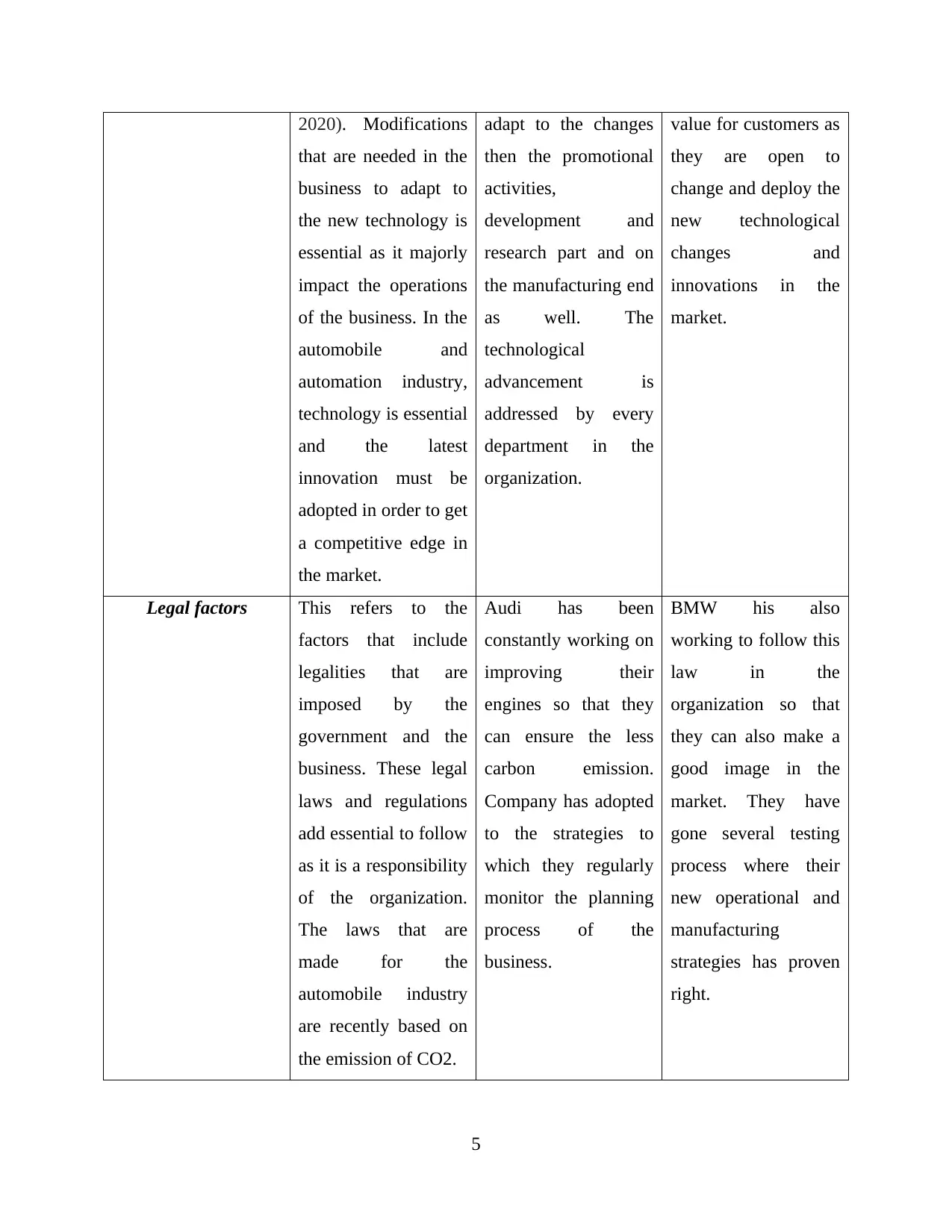
2020). Modifications
that are needed in the
business to adapt to
the new technology is
essential as it majorly
impact the operations
of the business. In the
automobile and
automation industry,
technology is essential
and the latest
innovation must be
adopted in order to get
a competitive edge in
the market.
adapt to the changes
then the promotional
activities,
development and
research part and on
the manufacturing end
as well. The
technological
advancement is
addressed by every
department in the
organization.
value for customers as
they are open to
change and deploy the
new technological
changes and
innovations in the
market.
Legal factors This refers to the
factors that include
legalities that are
imposed by the
government and the
business. These legal
laws and regulations
add essential to follow
as it is a responsibility
of the organization.
The laws that are
made for the
automobile industry
are recently based on
the emission of CO2.
Audi has been
constantly working on
improving their
engines so that they
can ensure the less
carbon emission.
Company has adopted
to the strategies to
which they regularly
monitor the planning
process of the
business.
BMW his also
working to follow this
law in the
organization so that
they can also make a
good image in the
market. They have
gone several testing
process where their
new operational and
manufacturing
strategies has proven
right.
5
that are needed in the
business to adapt to
the new technology is
essential as it majorly
impact the operations
of the business. In the
automobile and
automation industry,
technology is essential
and the latest
innovation must be
adopted in order to get
a competitive edge in
the market.
adapt to the changes
then the promotional
activities,
development and
research part and on
the manufacturing end
as well. The
technological
advancement is
addressed by every
department in the
organization.
value for customers as
they are open to
change and deploy the
new technological
changes and
innovations in the
market.
Legal factors This refers to the
factors that include
legalities that are
imposed by the
government and the
business. These legal
laws and regulations
add essential to follow
as it is a responsibility
of the organization.
The laws that are
made for the
automobile industry
are recently based on
the emission of CO2.
Audi has been
constantly working on
improving their
engines so that they
can ensure the less
carbon emission.
Company has adopted
to the strategies to
which they regularly
monitor the planning
process of the
business.
BMW his also
working to follow this
law in the
organization so that
they can also make a
good image in the
market. They have
gone several testing
process where their
new operational and
manufacturing
strategies has proven
right.
5
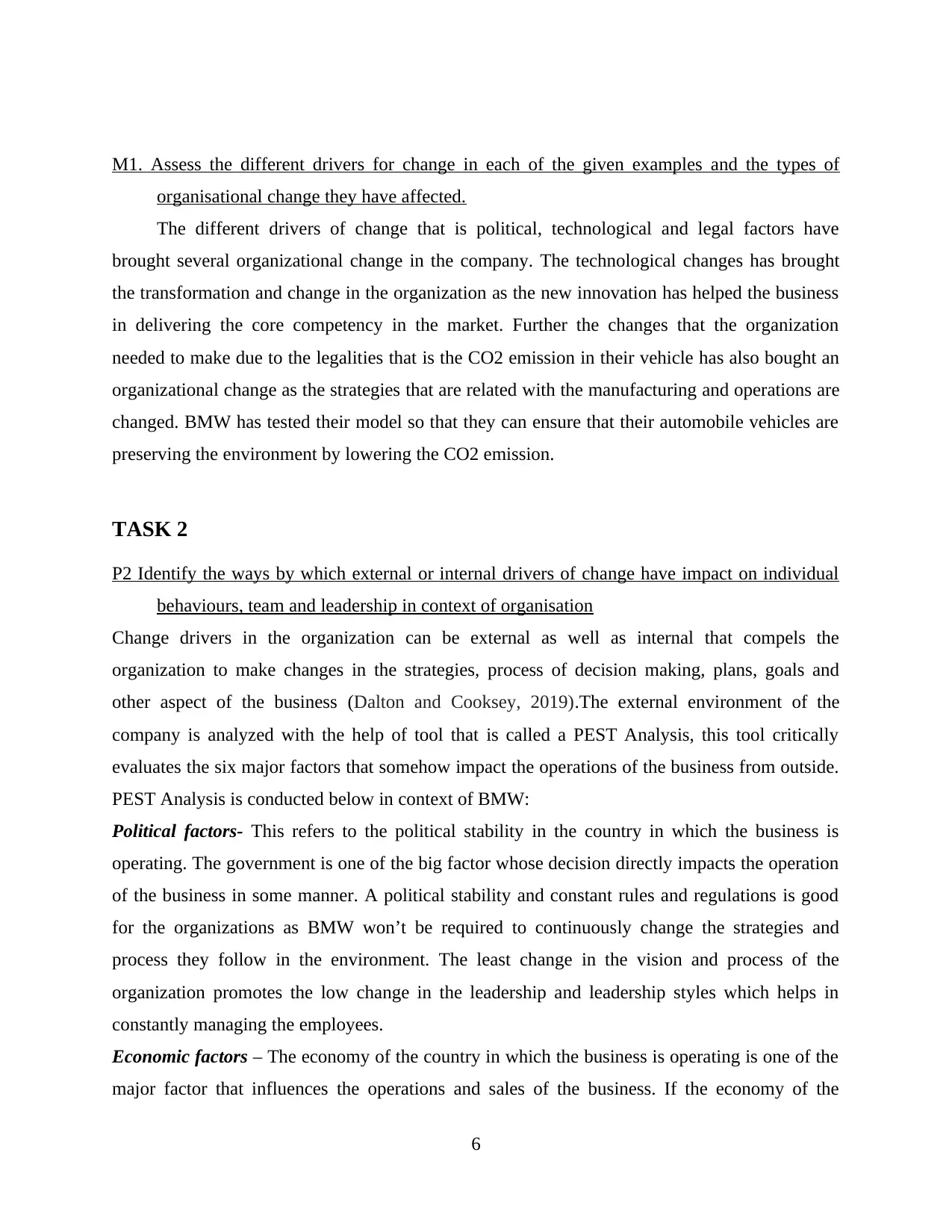
M1. Assess the different drivers for change in each of the given examples and the types of
organisational change they have affected.
The different drivers of change that is political, technological and legal factors have
brought several organizational change in the company. The technological changes has brought
the transformation and change in the organization as the new innovation has helped the business
in delivering the core competency in the market. Further the changes that the organization
needed to make due to the legalities that is the CO2 emission in their vehicle has also bought an
organizational change as the strategies that are related with the manufacturing and operations are
changed. BMW has tested their model so that they can ensure that their automobile vehicles are
preserving the environment by lowering the CO2 emission.
TASK 2
P2 Identify the ways by which external or internal drivers of change have impact on individual
behaviours, team and leadership in context of organisation
Change drivers in the organization can be external as well as internal that compels the
organization to make changes in the strategies, process of decision making, plans, goals and
other aspect of the business (Dalton and Cooksey, 2019).The external environment of the
company is analyzed with the help of tool that is called a PEST Analysis, this tool critically
evaluates the six major factors that somehow impact the operations of the business from outside.
PEST Analysis is conducted below in context of BMW:
Political factors- This refers to the political stability in the country in which the business is
operating. The government is one of the big factor whose decision directly impacts the operation
of the business in some manner. A political stability and constant rules and regulations is good
for the organizations as BMW won’t be required to continuously change the strategies and
process they follow in the environment. The least change in the vision and process of the
organization promotes the low change in the leadership and leadership styles which helps in
constantly managing the employees.
Economic factors – The economy of the country in which the business is operating is one of the
major factor that influences the operations and sales of the business. If the economy of the
6
organisational change they have affected.
The different drivers of change that is political, technological and legal factors have
brought several organizational change in the company. The technological changes has brought
the transformation and change in the organization as the new innovation has helped the business
in delivering the core competency in the market. Further the changes that the organization
needed to make due to the legalities that is the CO2 emission in their vehicle has also bought an
organizational change as the strategies that are related with the manufacturing and operations are
changed. BMW has tested their model so that they can ensure that their automobile vehicles are
preserving the environment by lowering the CO2 emission.
TASK 2
P2 Identify the ways by which external or internal drivers of change have impact on individual
behaviours, team and leadership in context of organisation
Change drivers in the organization can be external as well as internal that compels the
organization to make changes in the strategies, process of decision making, plans, goals and
other aspect of the business (Dalton and Cooksey, 2019).The external environment of the
company is analyzed with the help of tool that is called a PEST Analysis, this tool critically
evaluates the six major factors that somehow impact the operations of the business from outside.
PEST Analysis is conducted below in context of BMW:
Political factors- This refers to the political stability in the country in which the business is
operating. The government is one of the big factor whose decision directly impacts the operation
of the business in some manner. A political stability and constant rules and regulations is good
for the organizations as BMW won’t be required to continuously change the strategies and
process they follow in the environment. The least change in the vision and process of the
organization promotes the low change in the leadership and leadership styles which helps in
constantly managing the employees.
Economic factors – The economy of the country in which the business is operating is one of the
major factor that influences the operations and sales of the business. If the economy of the
6
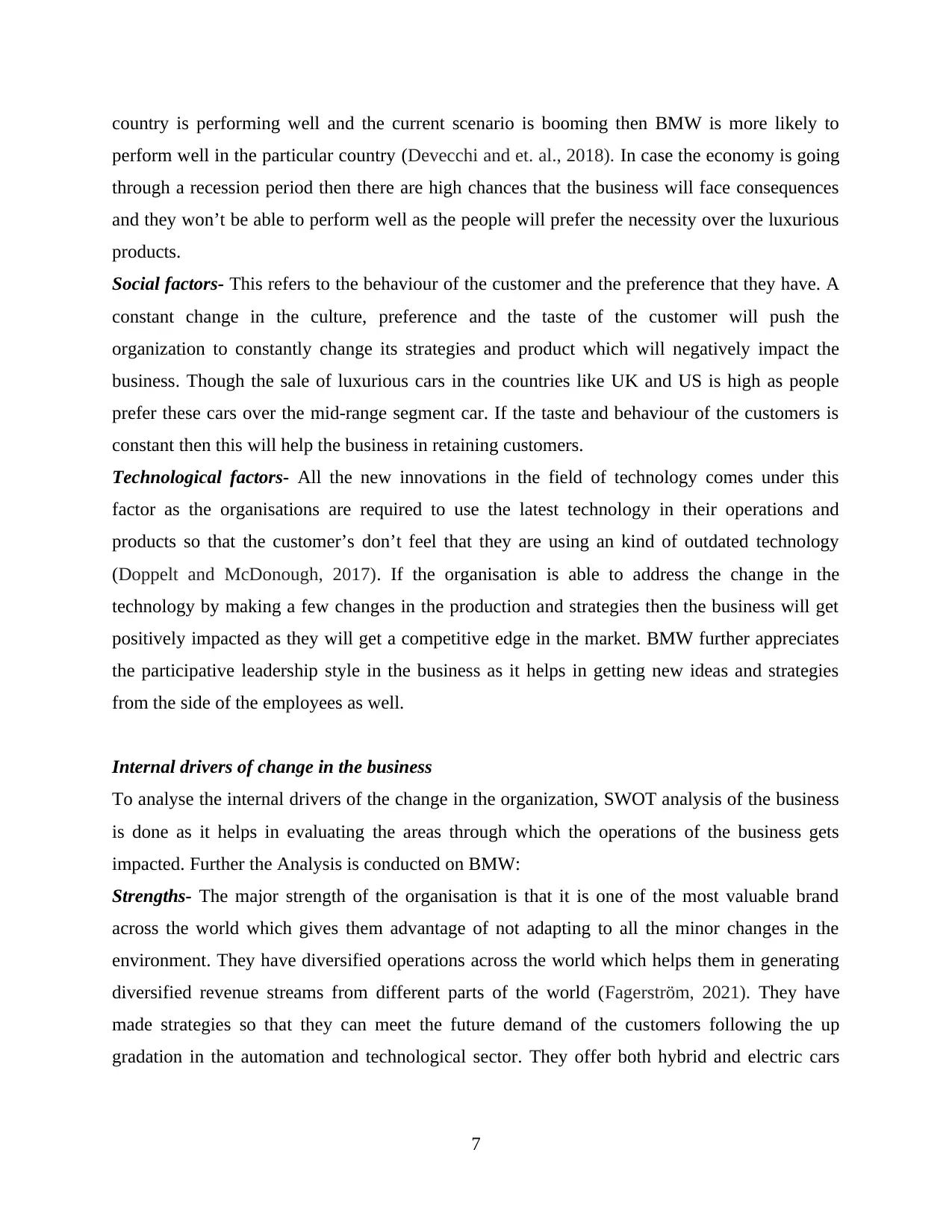
country is performing well and the current scenario is booming then BMW is more likely to
perform well in the particular country (Devecchi and et. al., 2018). In case the economy is going
through a recession period then there are high chances that the business will face consequences
and they won’t be able to perform well as the people will prefer the necessity over the luxurious
products.
Social factors- This refers to the behaviour of the customer and the preference that they have. A
constant change in the culture, preference and the taste of the customer will push the
organization to constantly change its strategies and product which will negatively impact the
business. Though the sale of luxurious cars in the countries like UK and US is high as people
prefer these cars over the mid-range segment car. If the taste and behaviour of the customers is
constant then this will help the business in retaining customers.
Technological factors- All the new innovations in the field of technology comes under this
factor as the organisations are required to use the latest technology in their operations and
products so that the customer’s don’t feel that they are using an kind of outdated technology
(Doppelt and McDonough, 2017). If the organisation is able to address the change in the
technology by making a few changes in the production and strategies then the business will get
positively impacted as they will get a competitive edge in the market. BMW further appreciates
the participative leadership style in the business as it helps in getting new ideas and strategies
from the side of the employees as well.
Internal drivers of change in the business
To analyse the internal drivers of the change in the organization, SWOT analysis of the business
is done as it helps in evaluating the areas through which the operations of the business gets
impacted. Further the Analysis is conducted on BMW:
Strengths- The major strength of the organisation is that it is one of the most valuable brand
across the world which gives them advantage of not adapting to all the minor changes in the
environment. They have diversified operations across the world which helps them in generating
diversified revenue streams from different parts of the world (Fagerström, 2021). They have
made strategies so that they can meet the future demand of the customers following the up
gradation in the automation and technological sector. They offer both hybrid and electric cars
7
perform well in the particular country (Devecchi and et. al., 2018). In case the economy is going
through a recession period then there are high chances that the business will face consequences
and they won’t be able to perform well as the people will prefer the necessity over the luxurious
products.
Social factors- This refers to the behaviour of the customer and the preference that they have. A
constant change in the culture, preference and the taste of the customer will push the
organization to constantly change its strategies and product which will negatively impact the
business. Though the sale of luxurious cars in the countries like UK and US is high as people
prefer these cars over the mid-range segment car. If the taste and behaviour of the customers is
constant then this will help the business in retaining customers.
Technological factors- All the new innovations in the field of technology comes under this
factor as the organisations are required to use the latest technology in their operations and
products so that the customer’s don’t feel that they are using an kind of outdated technology
(Doppelt and McDonough, 2017). If the organisation is able to address the change in the
technology by making a few changes in the production and strategies then the business will get
positively impacted as they will get a competitive edge in the market. BMW further appreciates
the participative leadership style in the business as it helps in getting new ideas and strategies
from the side of the employees as well.
Internal drivers of change in the business
To analyse the internal drivers of the change in the organization, SWOT analysis of the business
is done as it helps in evaluating the areas through which the operations of the business gets
impacted. Further the Analysis is conducted on BMW:
Strengths- The major strength of the organisation is that it is one of the most valuable brand
across the world which gives them advantage of not adapting to all the minor changes in the
environment. They have diversified operations across the world which helps them in generating
diversified revenue streams from different parts of the world (Fagerström, 2021). They have
made strategies so that they can meet the future demand of the customers following the up
gradation in the automation and technological sector. They offer both hybrid and electric cars
7
Secure Best Marks with AI Grader
Need help grading? Try our AI Grader for instant feedback on your assignments.
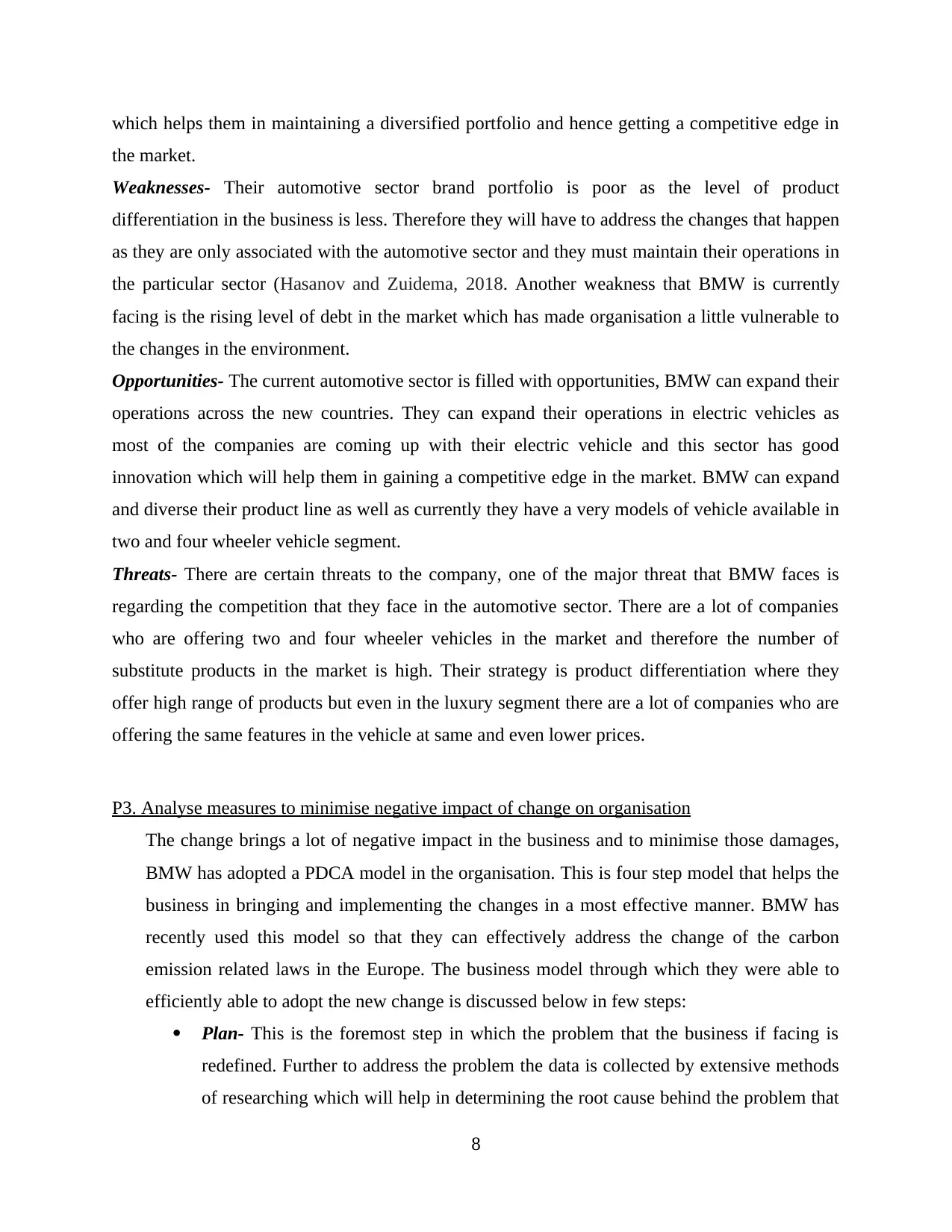
which helps them in maintaining a diversified portfolio and hence getting a competitive edge in
the market.
Weaknesses- Their automotive sector brand portfolio is poor as the level of product
differentiation in the business is less. Therefore they will have to address the changes that happen
as they are only associated with the automotive sector and they must maintain their operations in
the particular sector (Hasanov and Zuidema, 2018. Another weakness that BMW is currently
facing is the rising level of debt in the market which has made organisation a little vulnerable to
the changes in the environment.
Opportunities- The current automotive sector is filled with opportunities, BMW can expand their
operations across the new countries. They can expand their operations in electric vehicles as
most of the companies are coming up with their electric vehicle and this sector has good
innovation which will help them in gaining a competitive edge in the market. BMW can expand
and diverse their product line as well as currently they have a very models of vehicle available in
two and four wheeler vehicle segment.
Threats- There are certain threats to the company, one of the major threat that BMW faces is
regarding the competition that they face in the automotive sector. There are a lot of companies
who are offering two and four wheeler vehicles in the market and therefore the number of
substitute products in the market is high. Their strategy is product differentiation where they
offer high range of products but even in the luxury segment there are a lot of companies who are
offering the same features in the vehicle at same and even lower prices.
P3. Analyse measures to minimise negative impact of change on organisation
The change brings a lot of negative impact in the business and to minimise those damages,
BMW has adopted a PDCA model in the organisation. This is four step model that helps the
business in bringing and implementing the changes in a most effective manner. BMW has
recently used this model so that they can effectively address the change of the carbon
emission related laws in the Europe. The business model through which they were able to
efficiently able to adopt the new change is discussed below in few steps:
Plan- This is the foremost step in which the problem that the business if facing is
redefined. Further to address the problem the data is collected by extensive methods
of researching which will help in determining the root cause behind the problem that
8
the market.
Weaknesses- Their automotive sector brand portfolio is poor as the level of product
differentiation in the business is less. Therefore they will have to address the changes that happen
as they are only associated with the automotive sector and they must maintain their operations in
the particular sector (Hasanov and Zuidema, 2018. Another weakness that BMW is currently
facing is the rising level of debt in the market which has made organisation a little vulnerable to
the changes in the environment.
Opportunities- The current automotive sector is filled with opportunities, BMW can expand their
operations across the new countries. They can expand their operations in electric vehicles as
most of the companies are coming up with their electric vehicle and this sector has good
innovation which will help them in gaining a competitive edge in the market. BMW can expand
and diverse their product line as well as currently they have a very models of vehicle available in
two and four wheeler vehicle segment.
Threats- There are certain threats to the company, one of the major threat that BMW faces is
regarding the competition that they face in the automotive sector. There are a lot of companies
who are offering two and four wheeler vehicles in the market and therefore the number of
substitute products in the market is high. Their strategy is product differentiation where they
offer high range of products but even in the luxury segment there are a lot of companies who are
offering the same features in the vehicle at same and even lower prices.
P3. Analyse measures to minimise negative impact of change on organisation
The change brings a lot of negative impact in the business and to minimise those damages,
BMW has adopted a PDCA model in the organisation. This is four step model that helps the
business in bringing and implementing the changes in a most effective manner. BMW has
recently used this model so that they can effectively address the change of the carbon
emission related laws in the Europe. The business model through which they were able to
efficiently able to adopt the new change is discussed below in few steps:
Plan- This is the foremost step in which the problem that the business if facing is
redefined. Further to address the problem the data is collected by extensive methods
of researching which will help in determining the root cause behind the problem that
8
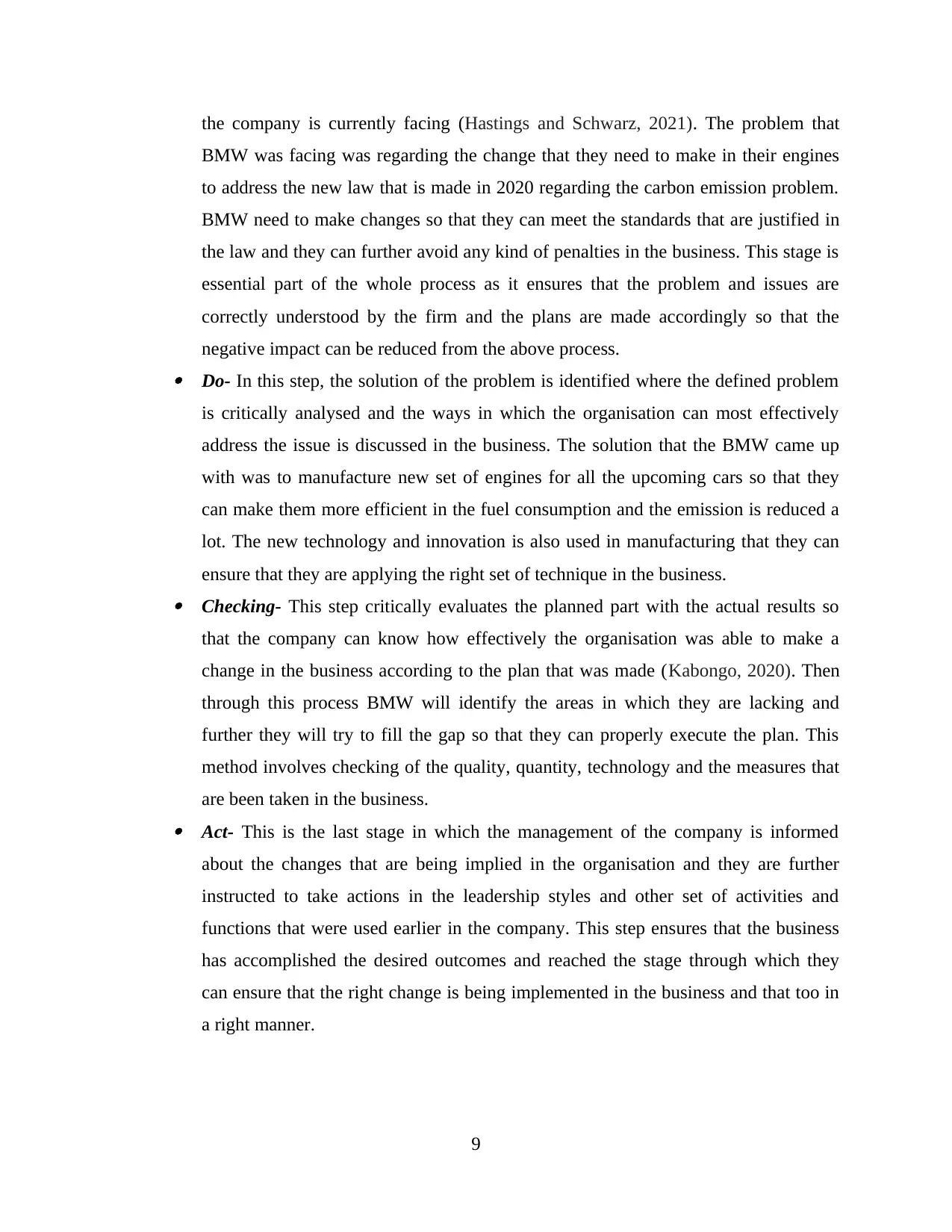
the company is currently facing (Hastings and Schwarz, 2021). The problem that
BMW was facing was regarding the change that they need to make in their engines
to address the new law that is made in 2020 regarding the carbon emission problem.
BMW need to make changes so that they can meet the standards that are justified in
the law and they can further avoid any kind of penalties in the business. This stage is
essential part of the whole process as it ensures that the problem and issues are
correctly understood by the firm and the plans are made accordingly so that the
negative impact can be reduced from the above process.
Do- In this step, the solution of the problem is identified where the defined problem
is critically analysed and the ways in which the organisation can most effectively
address the issue is discussed in the business. The solution that the BMW came up
with was to manufacture new set of engines for all the upcoming cars so that they
can make them more efficient in the fuel consumption and the emission is reduced a
lot. The new technology and innovation is also used in manufacturing that they can
ensure that they are applying the right set of technique in the business.
Checking- This step critically evaluates the planned part with the actual results so
that the company can know how effectively the organisation was able to make a
change in the business according to the plan that was made (Kabongo, 2020). Then
through this process BMW will identify the areas in which they are lacking and
further they will try to fill the gap so that they can properly execute the plan. This
method involves checking of the quality, quantity, technology and the measures that
are been taken in the business.
Act- This is the last stage in which the management of the company is informed
about the changes that are being implied in the organisation and they are further
instructed to take actions in the leadership styles and other set of activities and
functions that were used earlier in the company. This step ensures that the business
has accomplished the desired outcomes and reached the stage through which they
can ensure that the right change is being implemented in the business and that too in
a right manner.
9
BMW was facing was regarding the change that they need to make in their engines
to address the new law that is made in 2020 regarding the carbon emission problem.
BMW need to make changes so that they can meet the standards that are justified in
the law and they can further avoid any kind of penalties in the business. This stage is
essential part of the whole process as it ensures that the problem and issues are
correctly understood by the firm and the plans are made accordingly so that the
negative impact can be reduced from the above process.
Do- In this step, the solution of the problem is identified where the defined problem
is critically analysed and the ways in which the organisation can most effectively
address the issue is discussed in the business. The solution that the BMW came up
with was to manufacture new set of engines for all the upcoming cars so that they
can make them more efficient in the fuel consumption and the emission is reduced a
lot. The new technology and innovation is also used in manufacturing that they can
ensure that they are applying the right set of technique in the business.
Checking- This step critically evaluates the planned part with the actual results so
that the company can know how effectively the organisation was able to make a
change in the business according to the plan that was made (Kabongo, 2020). Then
through this process BMW will identify the areas in which they are lacking and
further they will try to fill the gap so that they can properly execute the plan. This
method involves checking of the quality, quantity, technology and the measures that
are been taken in the business.
Act- This is the last stage in which the management of the company is informed
about the changes that are being implied in the organisation and they are further
instructed to take actions in the leadership styles and other set of activities and
functions that were used earlier in the company. This step ensures that the business
has accomplished the desired outcomes and reached the stage through which they
can ensure that the right change is being implemented in the business and that too in
a right manner.
9
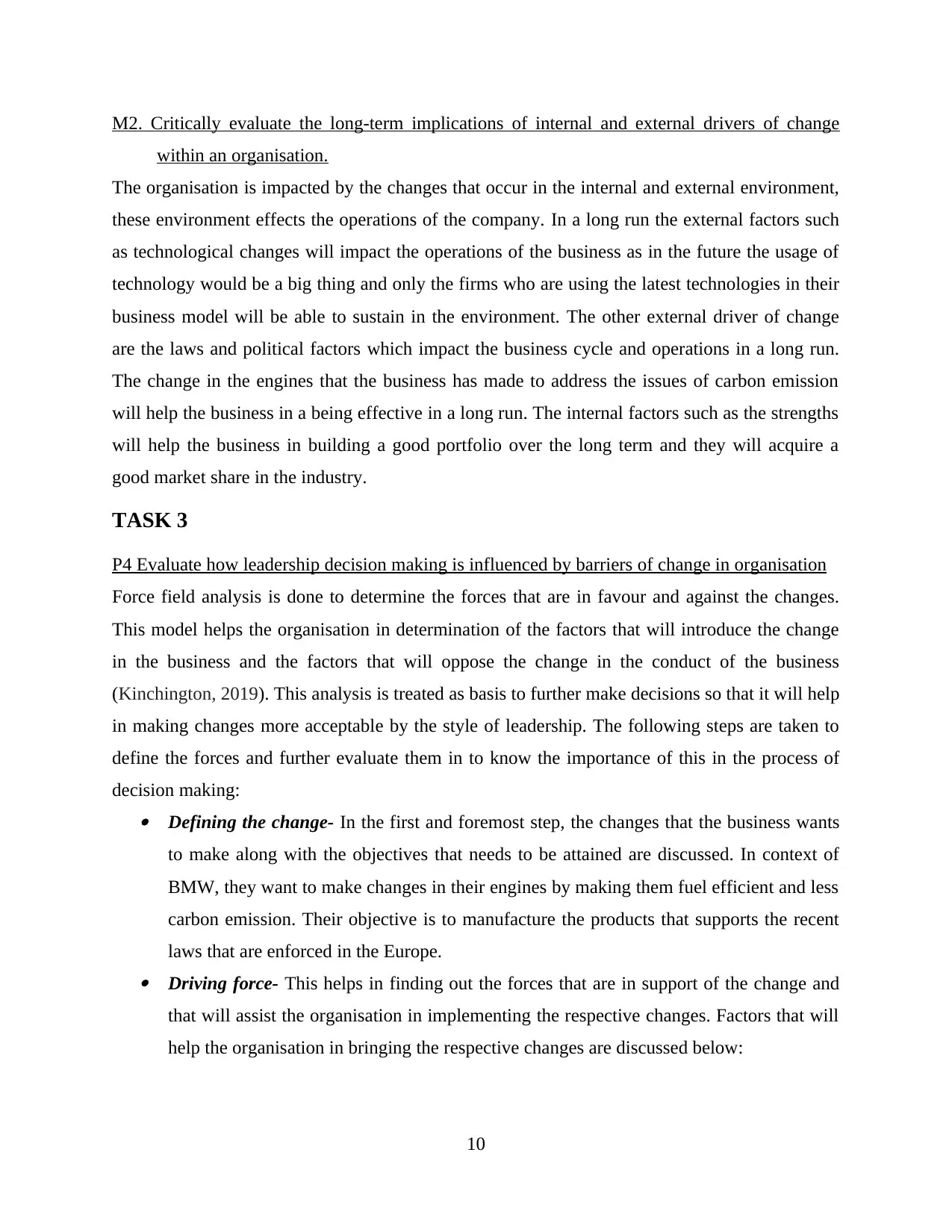
M2. Critically evaluate the long-term implications of internal and external drivers of change
within an organisation.
The organisation is impacted by the changes that occur in the internal and external environment,
these environment effects the operations of the company. In a long run the external factors such
as technological changes will impact the operations of the business as in the future the usage of
technology would be a big thing and only the firms who are using the latest technologies in their
business model will be able to sustain in the environment. The other external driver of change
are the laws and political factors which impact the business cycle and operations in a long run.
The change in the engines that the business has made to address the issues of carbon emission
will help the business in a being effective in a long run. The internal factors such as the strengths
will help the business in building a good portfolio over the long term and they will acquire a
good market share in the industry.
TASK 3
P4 Evaluate how leadership decision making is influenced by barriers of change in organisation
Force field analysis is done to determine the forces that are in favour and against the changes.
This model helps the organisation in determination of the factors that will introduce the change
in the business and the factors that will oppose the change in the conduct of the business
(Kinchington, 2019). This analysis is treated as basis to further make decisions so that it will help
in making changes more acceptable by the style of leadership. The following steps are taken to
define the forces and further evaluate them in to know the importance of this in the process of
decision making: Defining the change- In the first and foremost step, the changes that the business wants
to make along with the objectives that needs to be attained are discussed. In context of
BMW, they want to make changes in their engines by making them fuel efficient and less
carbon emission. Their objective is to manufacture the products that supports the recent
laws that are enforced in the Europe. Driving force- This helps in finding out the forces that are in support of the change and
that will assist the organisation in implementing the respective changes. Factors that will
help the organisation in bringing the respective changes are discussed below:
10
within an organisation.
The organisation is impacted by the changes that occur in the internal and external environment,
these environment effects the operations of the company. In a long run the external factors such
as technological changes will impact the operations of the business as in the future the usage of
technology would be a big thing and only the firms who are using the latest technologies in their
business model will be able to sustain in the environment. The other external driver of change
are the laws and political factors which impact the business cycle and operations in a long run.
The change in the engines that the business has made to address the issues of carbon emission
will help the business in a being effective in a long run. The internal factors such as the strengths
will help the business in building a good portfolio over the long term and they will acquire a
good market share in the industry.
TASK 3
P4 Evaluate how leadership decision making is influenced by barriers of change in organisation
Force field analysis is done to determine the forces that are in favour and against the changes.
This model helps the organisation in determination of the factors that will introduce the change
in the business and the factors that will oppose the change in the conduct of the business
(Kinchington, 2019). This analysis is treated as basis to further make decisions so that it will help
in making changes more acceptable by the style of leadership. The following steps are taken to
define the forces and further evaluate them in to know the importance of this in the process of
decision making: Defining the change- In the first and foremost step, the changes that the business wants
to make along with the objectives that needs to be attained are discussed. In context of
BMW, they want to make changes in their engines by making them fuel efficient and less
carbon emission. Their objective is to manufacture the products that supports the recent
laws that are enforced in the Europe. Driving force- This helps in finding out the forces that are in support of the change and
that will assist the organisation in implementing the respective changes. Factors that will
help the organisation in bringing the respective changes are discussed below:
10
Paraphrase This Document
Need a fresh take? Get an instant paraphrase of this document with our AI Paraphraser
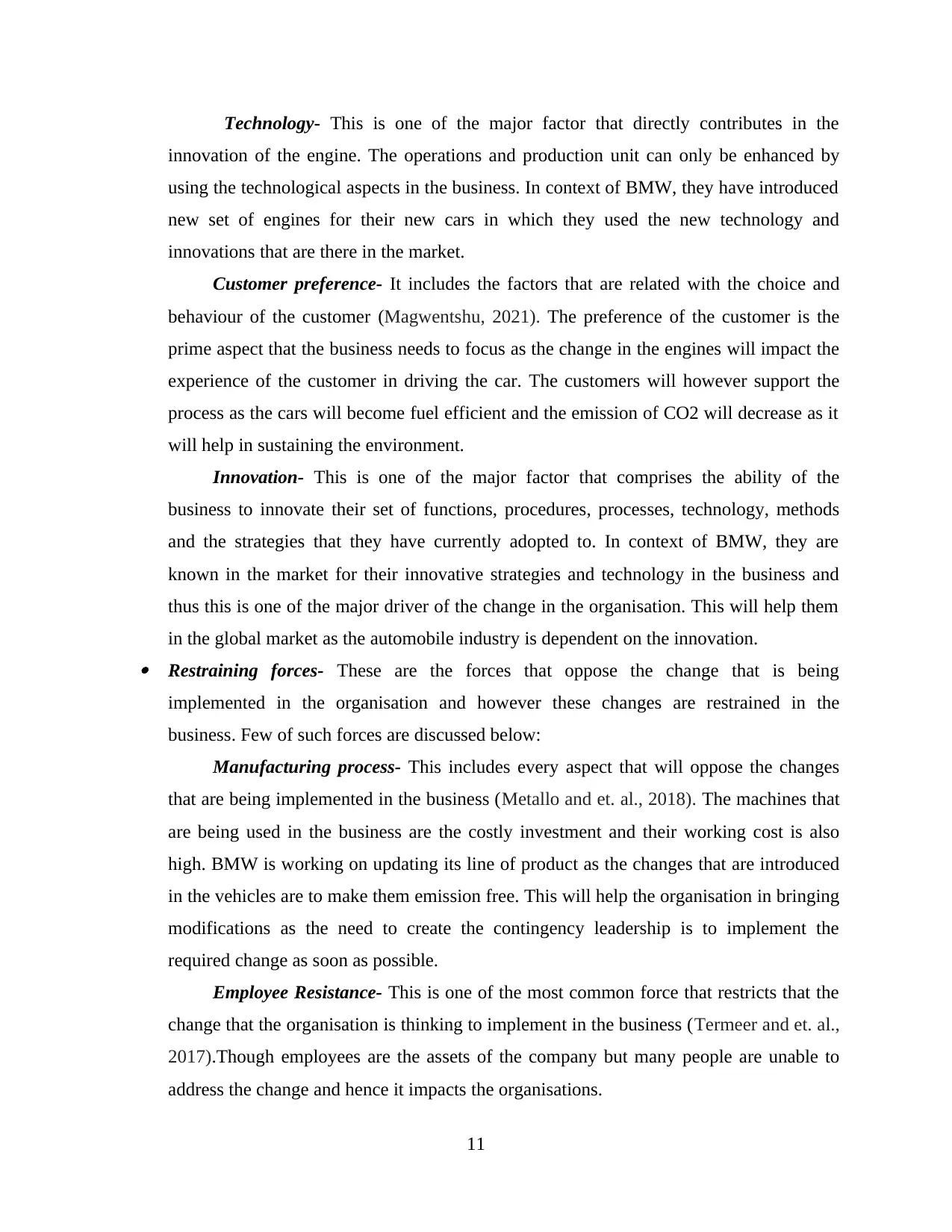
Technology- This is one of the major factor that directly contributes in the
innovation of the engine. The operations and production unit can only be enhanced by
using the technological aspects in the business. In context of BMW, they have introduced
new set of engines for their new cars in which they used the new technology and
innovations that are there in the market.
Customer preference- It includes the factors that are related with the choice and
behaviour of the customer (Magwentshu, 2021). The preference of the customer is the
prime aspect that the business needs to focus as the change in the engines will impact the
experience of the customer in driving the car. The customers will however support the
process as the cars will become fuel efficient and the emission of CO2 will decrease as it
will help in sustaining the environment.
Innovation- This is one of the major factor that comprises the ability of the
business to innovate their set of functions, procedures, processes, technology, methods
and the strategies that they have currently adopted to. In context of BMW, they are
known in the market for their innovative strategies and technology in the business and
thus this is one of the major driver of the change in the organisation. This will help them
in the global market as the automobile industry is dependent on the innovation. Restraining forces- These are the forces that oppose the change that is being
implemented in the organisation and however these changes are restrained in the
business. Few of such forces are discussed below:
Manufacturing process- This includes every aspect that will oppose the changes
that are being implemented in the business (Metallo and et. al., 2018). The machines that
are being used in the business are the costly investment and their working cost is also
high. BMW is working on updating its line of product as the changes that are introduced
in the vehicles are to make them emission free. This will help the organisation in bringing
modifications as the need to create the contingency leadership is to implement the
required change as soon as possible.
Employee Resistance- This is one of the most common force that restricts that the
change that the organisation is thinking to implement in the business (Termeer and et. al.,
2017).Though employees are the assets of the company but many people are unable to
address the change and hence it impacts the organisations.
11
innovation of the engine. The operations and production unit can only be enhanced by
using the technological aspects in the business. In context of BMW, they have introduced
new set of engines for their new cars in which they used the new technology and
innovations that are there in the market.
Customer preference- It includes the factors that are related with the choice and
behaviour of the customer (Magwentshu, 2021). The preference of the customer is the
prime aspect that the business needs to focus as the change in the engines will impact the
experience of the customer in driving the car. The customers will however support the
process as the cars will become fuel efficient and the emission of CO2 will decrease as it
will help in sustaining the environment.
Innovation- This is one of the major factor that comprises the ability of the
business to innovate their set of functions, procedures, processes, technology, methods
and the strategies that they have currently adopted to. In context of BMW, they are
known in the market for their innovative strategies and technology in the business and
thus this is one of the major driver of the change in the organisation. This will help them
in the global market as the automobile industry is dependent on the innovation. Restraining forces- These are the forces that oppose the change that is being
implemented in the organisation and however these changes are restrained in the
business. Few of such forces are discussed below:
Manufacturing process- This includes every aspect that will oppose the changes
that are being implemented in the business (Metallo and et. al., 2018). The machines that
are being used in the business are the costly investment and their working cost is also
high. BMW is working on updating its line of product as the changes that are introduced
in the vehicles are to make them emission free. This will help the organisation in bringing
modifications as the need to create the contingency leadership is to implement the
required change as soon as possible.
Employee Resistance- This is one of the most common force that restricts that the
change that the organisation is thinking to implement in the business (Termeer and et. al.,
2017).Though employees are the assets of the company but many people are unable to
address the change and hence it impacts the organisations.
11
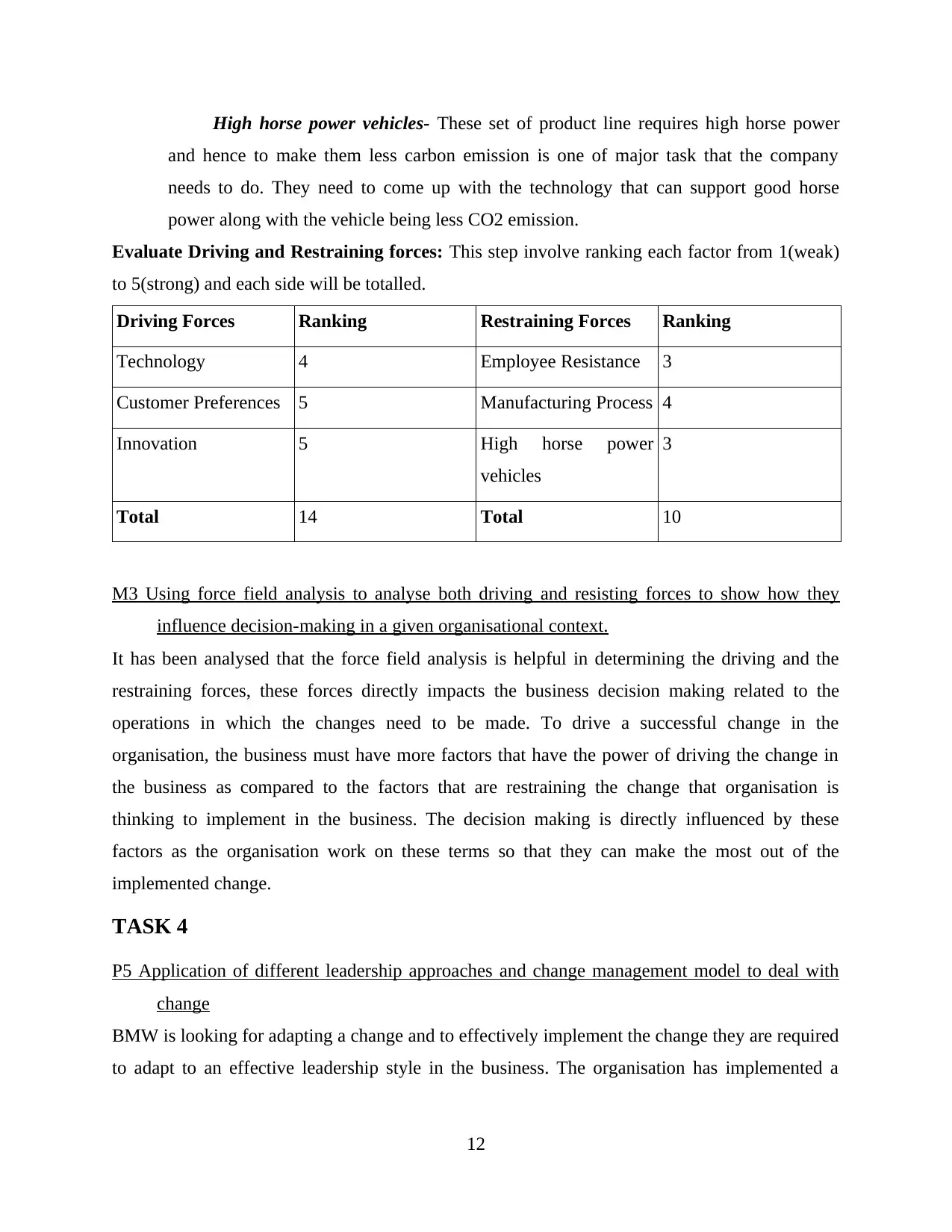
High horse power vehicles- These set of product line requires high horse power
and hence to make them less carbon emission is one of major task that the company
needs to do. They need to come up with the technology that can support good horse
power along with the vehicle being less CO2 emission.
Evaluate Driving and Restraining forces: This step involve ranking each factor from 1(weak)
to 5(strong) and each side will be totalled.
Driving Forces Ranking Restraining Forces Ranking
Technology 4 Employee Resistance 3
Customer Preferences 5 Manufacturing Process 4
Innovation 5 High horse power
vehicles
3
Total 14 Total 10
M3 Using force field analysis to analyse both driving and resisting forces to show how they
influence decision-making in a given organisational context.
It has been analysed that the force field analysis is helpful in determining the driving and the
restraining forces, these forces directly impacts the business decision making related to the
operations in which the changes need to be made. To drive a successful change in the
organisation, the business must have more factors that have the power of driving the change in
the business as compared to the factors that are restraining the change that organisation is
thinking to implement in the business. The decision making is directly influenced by these
factors as the organisation work on these terms so that they can make the most out of the
implemented change.
TASK 4
P5 Application of different leadership approaches and change management model to deal with
change
BMW is looking for adapting a change and to effectively implement the change they are required
to adapt to an effective leadership style in the business. The organisation has implemented a
12
and hence to make them less carbon emission is one of major task that the company
needs to do. They need to come up with the technology that can support good horse
power along with the vehicle being less CO2 emission.
Evaluate Driving and Restraining forces: This step involve ranking each factor from 1(weak)
to 5(strong) and each side will be totalled.
Driving Forces Ranking Restraining Forces Ranking
Technology 4 Employee Resistance 3
Customer Preferences 5 Manufacturing Process 4
Innovation 5 High horse power
vehicles
3
Total 14 Total 10
M3 Using force field analysis to analyse both driving and resisting forces to show how they
influence decision-making in a given organisational context.
It has been analysed that the force field analysis is helpful in determining the driving and the
restraining forces, these forces directly impacts the business decision making related to the
operations in which the changes need to be made. To drive a successful change in the
organisation, the business must have more factors that have the power of driving the change in
the business as compared to the factors that are restraining the change that organisation is
thinking to implement in the business. The decision making is directly influenced by these
factors as the organisation work on these terms so that they can make the most out of the
implemented change.
TASK 4
P5 Application of different leadership approaches and change management model to deal with
change
BMW is looking for adapting a change and to effectively implement the change they are required
to adapt to an effective leadership style in the business. The organisation has implemented a
12

mixture of two leadership style so that the business can well manage the change, the leadership
styles that are implemented in the business are discussed below: Strategic leadership style: In this type of leadership style, the leader is focused on
coming up with good strategies so that they can fill the gaps that the organisation is
currently facing. These leaders are open to the new set of innovations and technology
which helps the business in effectively making the change (Nadim and Singh, 2019).
BMW uses this leadership style as it assist the business in terms of reducing the conflicts
and the further encouraging the concept of team building in the business. An effective
team work is key in implementing the change and hence BMW uses this type of
leadership style in the business. Transformational leadership style: This leadership style is based on the concept of
initiating the change in the business and the operations that the business is performing.
These leaders motivate the employees and people associated with the business to put
extra efforts in the organisation so that the business can transform and implement the
changes. In context of BMW, they uses this as it increases the level of productivity in the
business along with the efficiency. It empowers the employees in giving their best so that
the organisation can grow along with the employees in the whole process.
Kotter’s 8 step change model
This model was proposed by Kotter to address the process that the business has to go
through while implementing a change in the functions and activities of the business. Dr.
Kotter came up with 8 step process so that the organisation can well execute the strategies
that they made. This approach was implemented by BMW while implementing the change
that they were making in the engines (Waddell and et. al., 2019). They followed the step by
step process where they started from creating urgency of making the change and take it all
the way to the anchoring of the change that is been made in the culture of the business.
Further the exact steps that is followed by the respective automotive company to implement
the change is shown below in the fig 1. The process build around the three factors that is first
creating a climate for the change in the business, moving on to engaging and enabling the
organisation to embrace the change that the organisation is looking to make and at the end
implementing and sustaining the respective change in the course of the business.
13
styles that are implemented in the business are discussed below: Strategic leadership style: In this type of leadership style, the leader is focused on
coming up with good strategies so that they can fill the gaps that the organisation is
currently facing. These leaders are open to the new set of innovations and technology
which helps the business in effectively making the change (Nadim and Singh, 2019).
BMW uses this leadership style as it assist the business in terms of reducing the conflicts
and the further encouraging the concept of team building in the business. An effective
team work is key in implementing the change and hence BMW uses this type of
leadership style in the business. Transformational leadership style: This leadership style is based on the concept of
initiating the change in the business and the operations that the business is performing.
These leaders motivate the employees and people associated with the business to put
extra efforts in the organisation so that the business can transform and implement the
changes. In context of BMW, they uses this as it increases the level of productivity in the
business along with the efficiency. It empowers the employees in giving their best so that
the organisation can grow along with the employees in the whole process.
Kotter’s 8 step change model
This model was proposed by Kotter to address the process that the business has to go
through while implementing a change in the functions and activities of the business. Dr.
Kotter came up with 8 step process so that the organisation can well execute the strategies
that they made. This approach was implemented by BMW while implementing the change
that they were making in the engines (Waddell and et. al., 2019). They followed the step by
step process where they started from creating urgency of making the change and take it all
the way to the anchoring of the change that is been made in the culture of the business.
Further the exact steps that is followed by the respective automotive company to implement
the change is shown below in the fig 1. The process build around the three factors that is first
creating a climate for the change in the business, moving on to engaging and enabling the
organisation to embrace the change that the organisation is looking to make and at the end
implementing and sustaining the respective change in the course of the business.
13
Secure Best Marks with AI Grader
Need help grading? Try our AI Grader for instant feedback on your assignments.
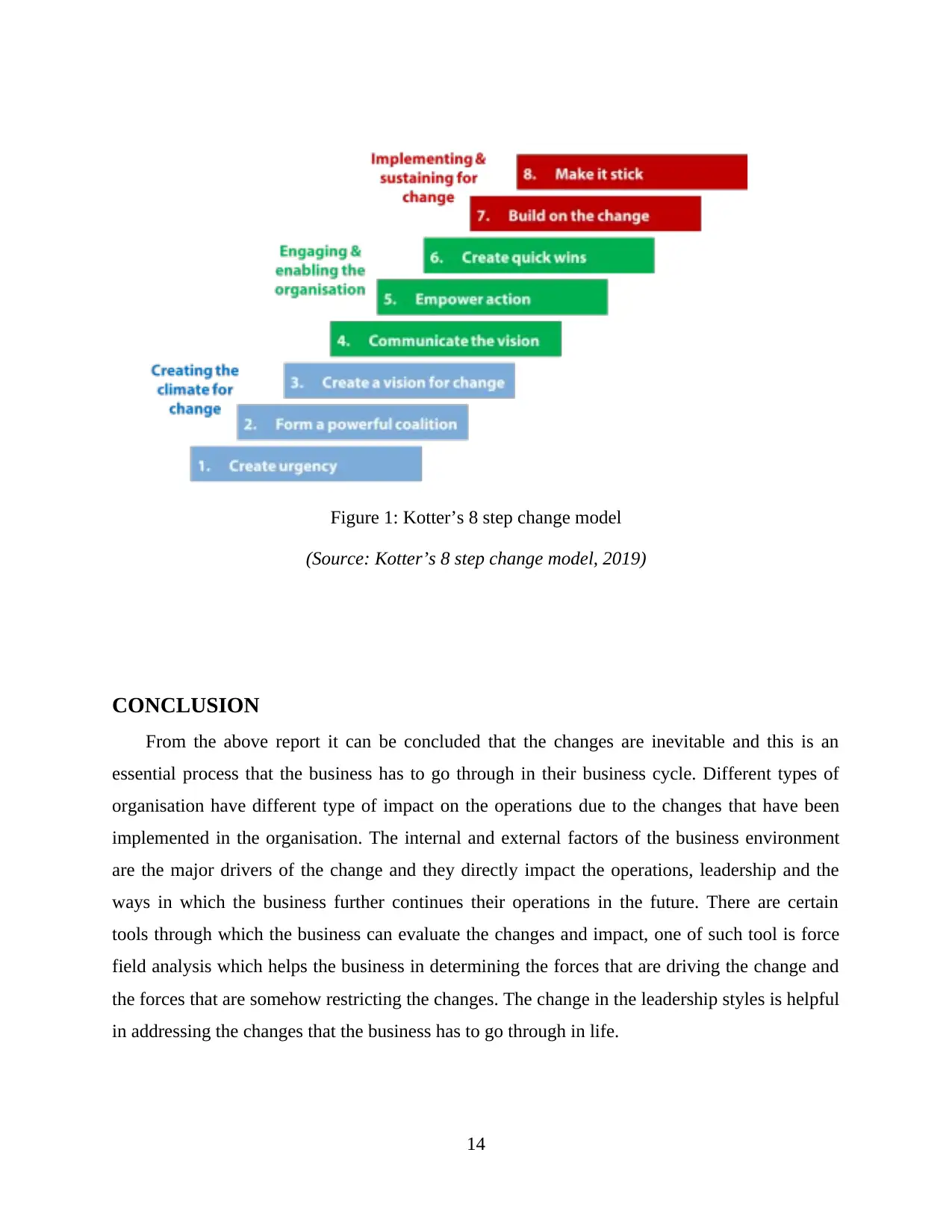
Figure 1: Kotter’s 8 step change model
(Source: Kotter’s 8 step change model, 2019)
CONCLUSION
From the above report it can be concluded that the changes are inevitable and this is an
essential process that the business has to go through in their business cycle. Different types of
organisation have different type of impact on the operations due to the changes that have been
implemented in the organisation. The internal and external factors of the business environment
are the major drivers of the change and they directly impact the operations, leadership and the
ways in which the business further continues their operations in the future. There are certain
tools through which the business can evaluate the changes and impact, one of such tool is force
field analysis which helps the business in determining the forces that are driving the change and
the forces that are somehow restricting the changes. The change in the leadership styles is helpful
in addressing the changes that the business has to go through in life.
14
(Source: Kotter’s 8 step change model, 2019)
CONCLUSION
From the above report it can be concluded that the changes are inevitable and this is an
essential process that the business has to go through in their business cycle. Different types of
organisation have different type of impact on the operations due to the changes that have been
implemented in the organisation. The internal and external factors of the business environment
are the major drivers of the change and they directly impact the operations, leadership and the
ways in which the business further continues their operations in the future. There are certain
tools through which the business can evaluate the changes and impact, one of such tool is force
field analysis which helps the business in determining the forces that are driving the change and
the forces that are somehow restricting the changes. The change in the leadership styles is helpful
in addressing the changes that the business has to go through in life.
14
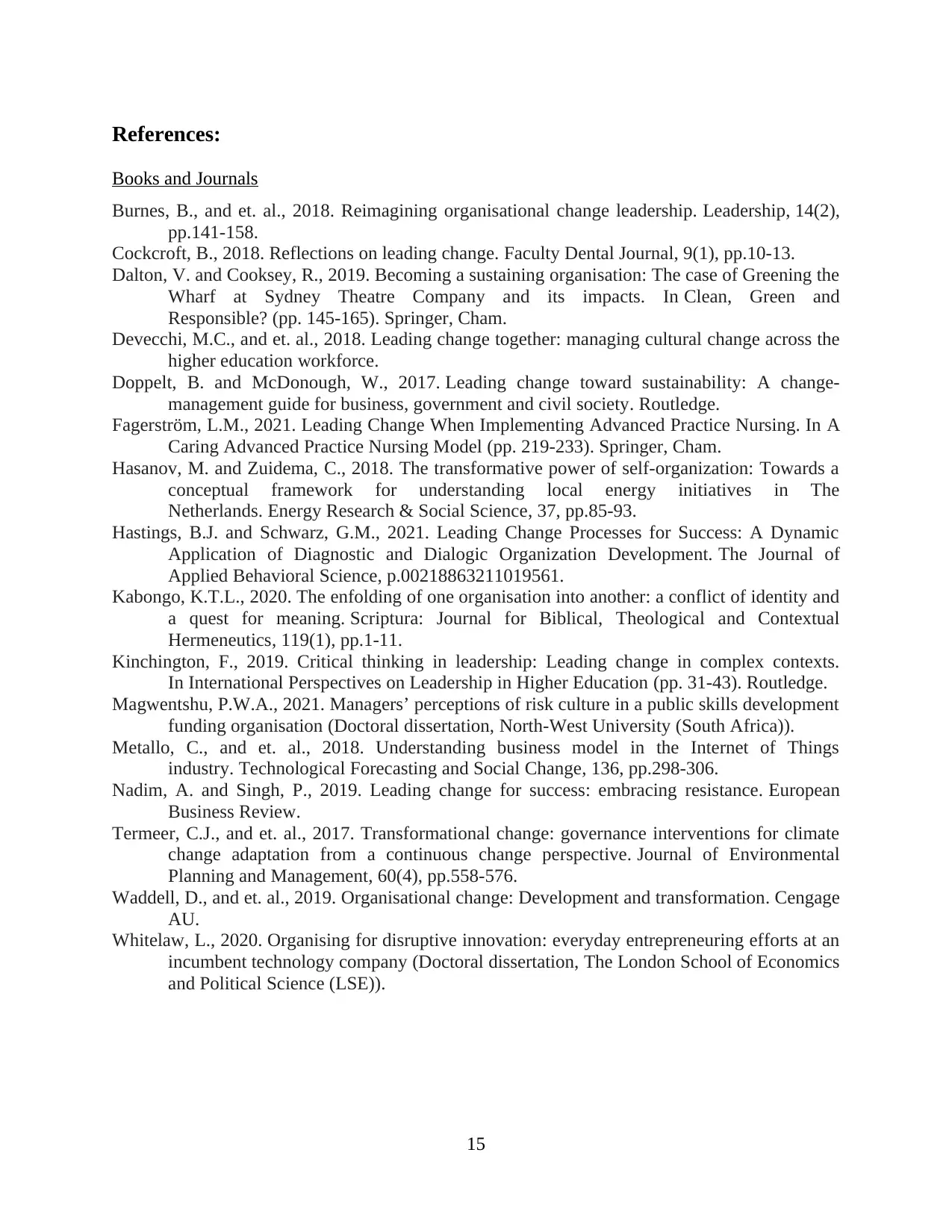
References:
Books and Journals
Burnes, B., and et. al., 2018. Reimagining organisational change leadership. Leadership, 14(2),
pp.141-158.
Cockcroft, B., 2018. Reflections on leading change. Faculty Dental Journal, 9(1), pp.10-13.
Dalton, V. and Cooksey, R., 2019. Becoming a sustaining organisation: The case of Greening the
Wharf at Sydney Theatre Company and its impacts. In Clean, Green and
Responsible? (pp. 145-165). Springer, Cham.
Devecchi, M.C., and et. al., 2018. Leading change together: managing cultural change across the
higher education workforce.
Doppelt, B. and McDonough, W., 2017. Leading change toward sustainability: A change-
management guide for business, government and civil society. Routledge.
Fagerström, L.M., 2021. Leading Change When Implementing Advanced Practice Nursing. In A
Caring Advanced Practice Nursing Model (pp. 219-233). Springer, Cham.
Hasanov, M. and Zuidema, C., 2018. The transformative power of self-organization: Towards a
conceptual framework for understanding local energy initiatives in The
Netherlands. Energy Research & Social Science, 37, pp.85-93.
Hastings, B.J. and Schwarz, G.M., 2021. Leading Change Processes for Success: A Dynamic
Application of Diagnostic and Dialogic Organization Development. The Journal of
Applied Behavioral Science, p.00218863211019561.
Kabongo, K.T.L., 2020. The enfolding of one organisation into another: a conflict of identity and
a quest for meaning. Scriptura: Journal for Biblical, Theological and Contextual
Hermeneutics, 119(1), pp.1-11.
Kinchington, F., 2019. Critical thinking in leadership: Leading change in complex contexts.
In International Perspectives on Leadership in Higher Education (pp. 31-43). Routledge.
Magwentshu, P.W.A., 2021. Managers’ perceptions of risk culture in a public skills development
funding organisation (Doctoral dissertation, North-West University (South Africa)).
Metallo, C., and et. al., 2018. Understanding business model in the Internet of Things
industry. Technological Forecasting and Social Change, 136, pp.298-306.
Nadim, A. and Singh, P., 2019. Leading change for success: embracing resistance. European
Business Review.
Termeer, C.J., and et. al., 2017. Transformational change: governance interventions for climate
change adaptation from a continuous change perspective. Journal of Environmental
Planning and Management, 60(4), pp.558-576.
Waddell, D., and et. al., 2019. Organisational change: Development and transformation. Cengage
AU.
Whitelaw, L., 2020. Organising for disruptive innovation: everyday entrepreneuring efforts at an
incumbent technology company (Doctoral dissertation, The London School of Economics
and Political Science (LSE)).
15
Books and Journals
Burnes, B., and et. al., 2018. Reimagining organisational change leadership. Leadership, 14(2),
pp.141-158.
Cockcroft, B., 2018. Reflections on leading change. Faculty Dental Journal, 9(1), pp.10-13.
Dalton, V. and Cooksey, R., 2019. Becoming a sustaining organisation: The case of Greening the
Wharf at Sydney Theatre Company and its impacts. In Clean, Green and
Responsible? (pp. 145-165). Springer, Cham.
Devecchi, M.C., and et. al., 2018. Leading change together: managing cultural change across the
higher education workforce.
Doppelt, B. and McDonough, W., 2017. Leading change toward sustainability: A change-
management guide for business, government and civil society. Routledge.
Fagerström, L.M., 2021. Leading Change When Implementing Advanced Practice Nursing. In A
Caring Advanced Practice Nursing Model (pp. 219-233). Springer, Cham.
Hasanov, M. and Zuidema, C., 2018. The transformative power of self-organization: Towards a
conceptual framework for understanding local energy initiatives in The
Netherlands. Energy Research & Social Science, 37, pp.85-93.
Hastings, B.J. and Schwarz, G.M., 2021. Leading Change Processes for Success: A Dynamic
Application of Diagnostic and Dialogic Organization Development. The Journal of
Applied Behavioral Science, p.00218863211019561.
Kabongo, K.T.L., 2020. The enfolding of one organisation into another: a conflict of identity and
a quest for meaning. Scriptura: Journal for Biblical, Theological and Contextual
Hermeneutics, 119(1), pp.1-11.
Kinchington, F., 2019. Critical thinking in leadership: Leading change in complex contexts.
In International Perspectives on Leadership in Higher Education (pp. 31-43). Routledge.
Magwentshu, P.W.A., 2021. Managers’ perceptions of risk culture in a public skills development
funding organisation (Doctoral dissertation, North-West University (South Africa)).
Metallo, C., and et. al., 2018. Understanding business model in the Internet of Things
industry. Technological Forecasting and Social Change, 136, pp.298-306.
Nadim, A. and Singh, P., 2019. Leading change for success: embracing resistance. European
Business Review.
Termeer, C.J., and et. al., 2017. Transformational change: governance interventions for climate
change adaptation from a continuous change perspective. Journal of Environmental
Planning and Management, 60(4), pp.558-576.
Waddell, D., and et. al., 2019. Organisational change: Development and transformation. Cengage
AU.
Whitelaw, L., 2020. Organising for disruptive innovation: everyday entrepreneuring efforts at an
incumbent technology company (Doctoral dissertation, The London School of Economics
and Political Science (LSE)).
15
1 out of 15
Related Documents
Your All-in-One AI-Powered Toolkit for Academic Success.
+13062052269
info@desklib.com
Available 24*7 on WhatsApp / Email
![[object Object]](/_next/static/media/star-bottom.7253800d.svg)
Unlock your academic potential
© 2024 | Zucol Services PVT LTD | All rights reserved.





